What we learn from multi-planet systems
Wei Zhu (祝伟)
Canadian Institute for Theoretical Astrophysics
\(\longrightarrow\) Tsinghua University (2021 March)
Exoplanet Demographics, 2020-11-11
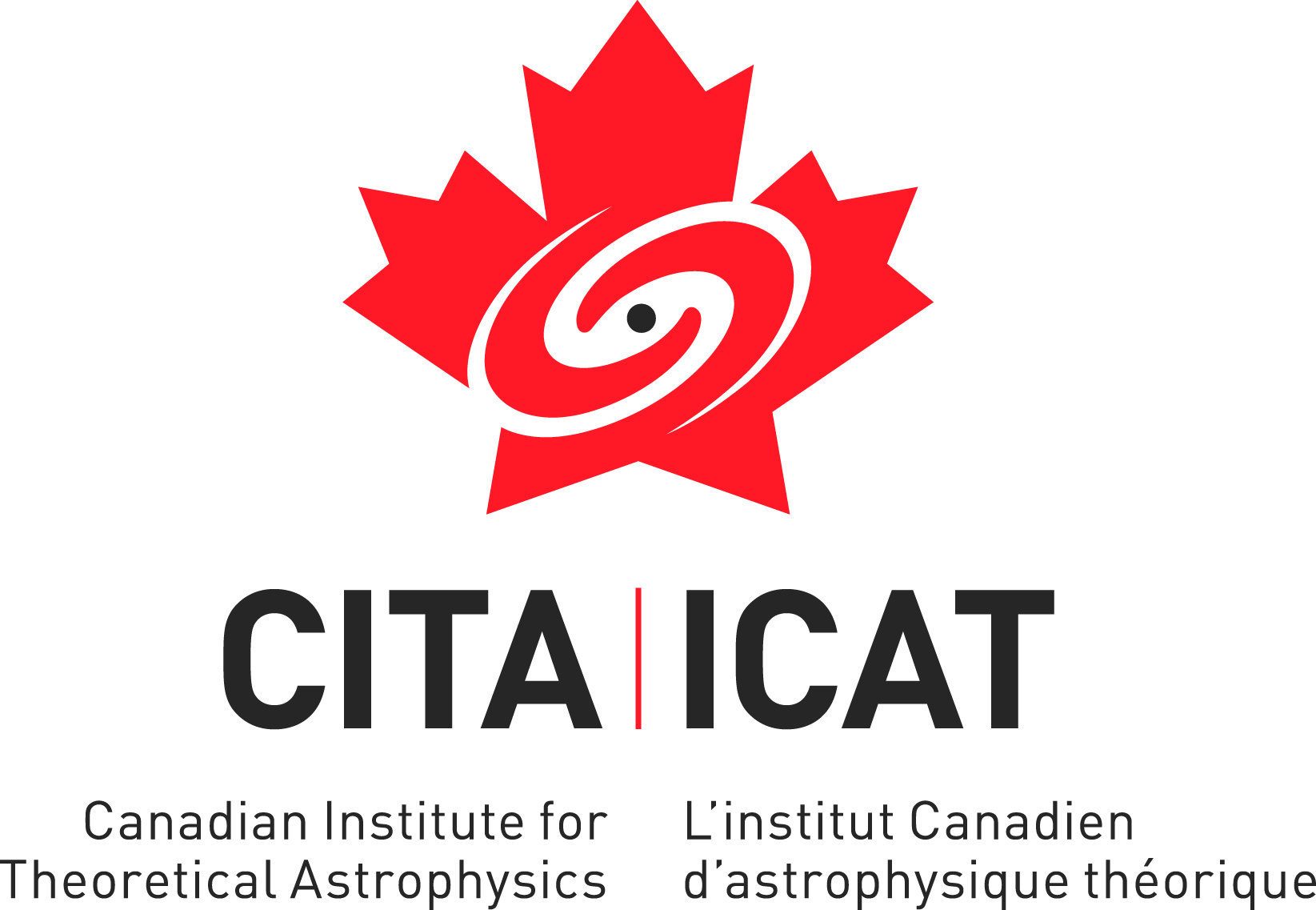



- Since April of 2019.
-
Exoplanet@Tsinghua:
- Xuening Bai (白雪宁), disk physics, planet formation;
- Shude Mao (毛淑德), gravitational (micro-)lensing, planet search;
- Chris Ormel, planet formation, protoplanetary disks;
- Sharon Wang (王雪凇), exoplanet detection & characterization;
- Wei Zhu (祝伟), exoplanet statistics & architecture, microlensing.
- Other fields of focus: high-energy astrophysics, cosmology and galaxy formation.
- We are hiring! At both faculty & post-doc levels.
http://astro.tsinghua.edu.cn/

Solar system as an example

- Planets have diverse properties (\(\sim10^2\) in separation and \(\sim10^4\) in mass).
- Planets have small but substantial orbital eccentricities (\(\lesssim0.2\)) and mutual inclinations (\(\lesssim 6^\circ\)).
- Solar system was once dynamically active, and may become chaotic again in \(\sim\) Gyr timescale.

Image credit: iLectureOnline
Solar system as an example


\(\Delta I = 5.7^\circ \quad \quad \quad 2.1^\circ \quad \quad \quad~~ 1.3^\circ \quad \quad \quad \quad 0.5^\circ ~~ \quad \quad \quad - \quad \quad \quad \quad 2.1^\circ \quad \quad \quad \quad 0.5^\circ \quad \quad \quad \quad 0.5^\circ \)
\(e = 0.21 \quad \quad \quad 0.01 \quad \quad 0.02 \quad \quad 0.06 ~~\quad \quad 0.05 \quad \quad \quad 0.06 \quad \quad 0.05 \quad \quad0.01 \)
- Planets have diverse properties (\(\sim10^2\) in separation and \(\sim10^4\) in mass).
- Planets have small but substantial orbital eccentricities and mutual inclinations.
- Solar system was once dynamically active, and may become chaotic again in \(\sim\) Gyr timescale.
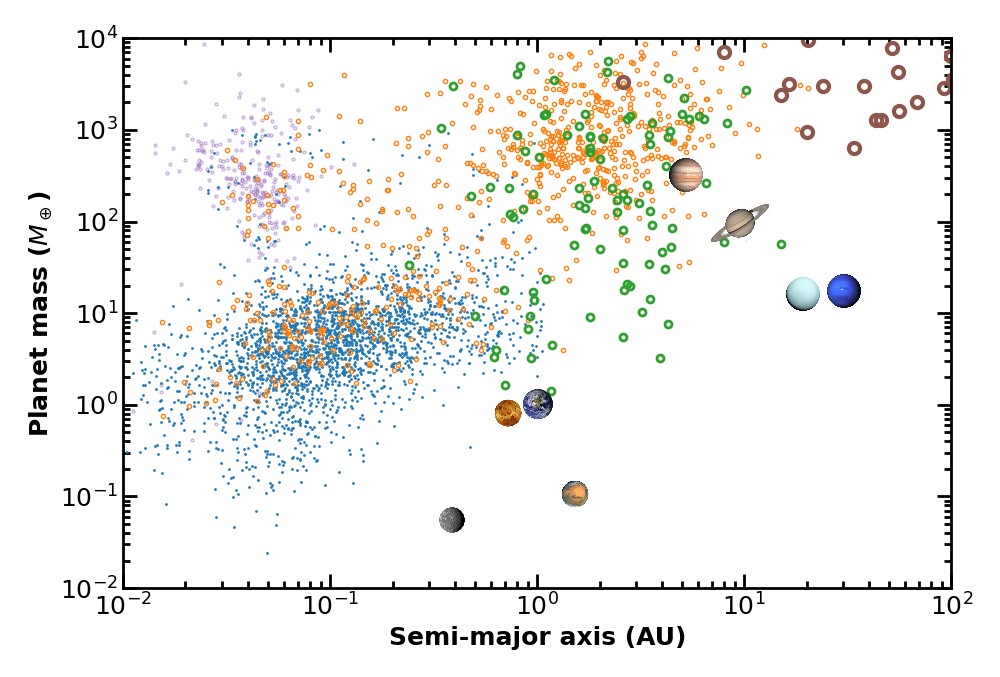
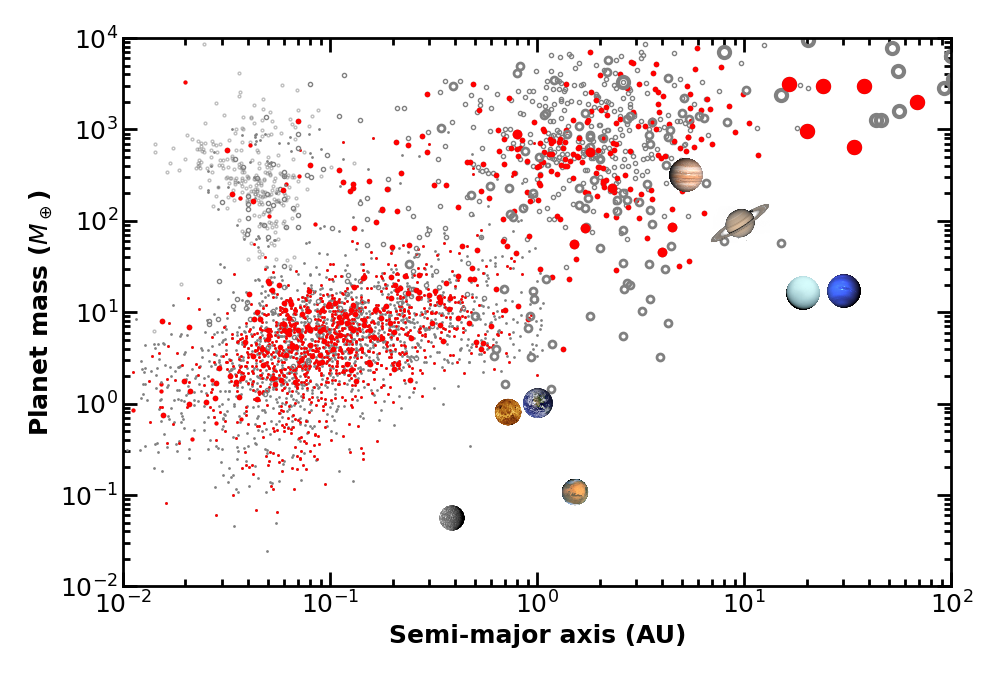
w/ known companions
w/o known companions
Transit (ground)
Transit (space)
RV
Microlensing
Imaging
Based on data from NASA Exoplanet Archive.
Are multi-planet systems flat?

- The weighted transit duration ratio (Steffen et al. 2010).
- Mutual inclination disperson \( \sigma_i\sim 3^\circ \) (e.g., Fang & Margot 2012, Fabrycky et al. 2014).
- A lower limit.
\( \xi \equiv \frac{\rm (Transit~chord~length)_{in}}{\rm (Transit~chord~length)_{\rm out}} = \frac{T_{\rm in} P_{\rm in}^{-1/3}}{T_{\rm out} P_{\rm out}^{-1/3}} = \sqrt{\frac{1-b_{\rm in}^2}{1-b_{\rm out}^2}} \)
Coplanarity \(\longrightarrow\) Kepler dichotomy?

Figure from Ballard & Johnson (2016)
- With a fixed mutual inclination distribution, at least two different populations of planetary systems are needed.
- Regardless of the intrinsic multiplicity distribution (e.g., Lissauer et al. 2011, Johansen et al. 2012, He et al. 2019).
-
Transit method cannot constrain the mutual inclination because of the degeneracy with intrinsic multiplicity.
- Transit + RV (Tremaine & Dong 2012, Figueira et al. 2012).
- Transit + TTV (Zhu et al. 2018).
Mutual inclination depends on multiplicity

Transit doubles
Transit triples
Transit quadruples
\( \xi = \frac{T_{\rm in} P_{\rm in}^{-1/3}}{T_{\rm out} P_{\rm out}^{-1/3}} = \sqrt{\frac{1-b_{\rm in}^2}{1-b_{\rm out}^2}} \)
- Weighted transit duration ratio
-
Systems with more planets have smaller mutual inclinations and are dynamically colder.
- E.g., Zhu et al. (2018), He et al. (2020).
Orbital eccentricity also depends multiplicity
- The transit duration method $$ \frac{T}{T_0} = \sqrt{1-b^2} \frac{\sqrt{1-e^2}}{1+e\sin{\omega}} $$ where \( T_0 \propto P^{1/3} \rho_\star^{-1/3} \).
- Transit singles have \(\sigma_e\approx0.3\), whereas transit multis have \(\sigma_e\approx0.05\) (Van Eylen et al. 2015, 2019, Xie et al. 2016, Mills et al. 2019).
-
Systems with more planets have smaller eccentricities and are dynamically colder.
- RV planets show a similar behaviour (e.g., Limbach & Turner 2015, Zinzi & Turrini 2017).

Transit singles
Transit doubles
Transit triples
Transit quadruples
Based on DR25 MCMC parameters and Berger et al. (2020) stellar parameters.
- Fewer-planet systems are dynamically hotter.
- Each system has on average 3 planets.
- Our solar systems fits "well" in this picture.
- Dynamical evolution may have reshaped the architecture.
Zhu et al., 2018
(see also He et al. 2020)
Kepler system intrinsic architecture

\( \sigma_i,~\sigma_e \propto k^\zeta \)

- Fewer-planet systems are dynamically hotter.
- Each system has on average 3 planets.
- Our solar systems fits "well" in this picture.
- Dynamical evolution may have reshaped the architecture.
Zhu et al., 2018
(see also He et al. 2020)
Orbital eccentricity
Kepler system intrinsic architecture




Planet-planet mutual inclinations affect the frequency of planetary systems
Coplanarity \(\longrightarrow\)>50% of Sun-like stars have Kepler-like planets (e.g., Fressin et al. 2013, Petigura et al. 2013).







mutual inclination

Planet-planet mutual inclinations affect the frequency of planetary systems

- Fraction of Sun-like stars with Kepler-like planets is ~30% (Zhu et al. 2018).
- Fraction of Sun-like stars with planets in an extended parameter space may be higher (e.g., Mulders et al. 2018, He et al. 2020).
- Or not, if planet occurrences are strongly correlated.


(Colors mean different multiplicities.)

- No strong preference for mean-motion resonances (e.g., Lissauer et al. 2011, Fabrycky et al. 2014).
- Spacing depends on multiplicity.
- ~80-90% of Kepler planet pairs do not allow intermediate planets (e.g., Fang & Margot 2013).
- Kepler systems are dynamically packed (e.g., Pu & Wu 2015). However, interior/exterior planets remain allowed.
Spacing in mutual Hill radii
On the intra-system variation
See Zhu (2020) and Murchikova & Tremaine (2020).

Figure adapted from Penny et al. (2019)
- Solar system planets have very diverse properties.
- In a (super-)Kepler's view, Solar system planets (Venus & Earth) have very similar properties.
Kepler system vs. Solar system

Figure adapted from Penny et al. (2019)
-
Kepler systems are massive.
- Inside 1 AU: 3 super Earths (~5 \(M_\oplus\)) vs. ~2 \(M_\oplus\).
Cold Jupiters
Super Earths
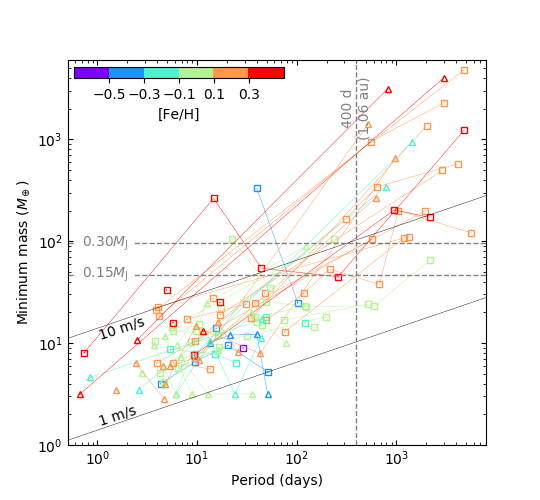
22 from Kepler (triangles) + 39 from RV (squares)
-
Super Earths preferentially have cold Jupiter companions $$ P({\rm CJ}|{\rm SE}) \approx33\% $$
- \( P({\rm CJ})=10\%\) (Cumming et al. 2008).
- \(P({\rm CJ}|{\rm SE})>50\%\), if [Fe/H]>0.
- Cold Jupiters almost always have inner super Earth companions $$ P({\rm SE}|{\rm CJ})=\frac{P({\rm CJ}|{\rm SE}) \cdot P({\rm SE})}{P({\rm CJ})} \approx100\% $$
Zhu & Wu (2018), Bryan et al. (2019)
Inner-outer correlation
Independent confirmations
-
Long-period (\(>2\,\)yr) transiting planets frequently have inner transiting companions.
- Herman, Zhu & Wu (2019); Masuda, Winn, & Kawahara (2020).
-
TESS detections of super Earths in RV cold Jupiter systems.
- pi Mensae (Huang et al. 2018, Gandolfi et al. 2018), HD 86226 (Teske et al. 2020)
- TESS + Gaia.

2 yr
Figure from Herman, Zhu & Wu (2019)
Strong inner-outer correlation challenging formation models of Kepler planets
-
Migration models typically expect anti- or no correlations:
- Formation-and-migration (e.g., Bern model, Schlecker et al. 2020).
- Migration-then-assembly (e.g., pebble accretion, Izidoro et al. 2015, Bitsch et al. 2019).
- In situ?

Pebbles (\(\sim\) cm)
Pebble isolation mass (\(\sim10\,M_\oplus\))

On the Poisson process assumption
- Fraction of stars with Kepler-like planets ~30%.
- Fraction of stars with cold giants ~10%.
-
Fraction of stars with planets in the joint parameter space?
- 37% [\(=1-(1-30\%)\times(1-10\%)\)] under the Poisson assumption.
- ~30%, because of the strong correlation.

Figure adapted from Penny et al. (2019)
(Un)Popularity of Solar system-like architecture
Figure from Zhu & Wu (2018)
- Systems with inner small planets and outer giant planets are a popular kind.
-
Systems very similar to ours are very rare.
- Solar system has no super Earth (~70%).
- Solar system has a cold Jupiter (~10%).
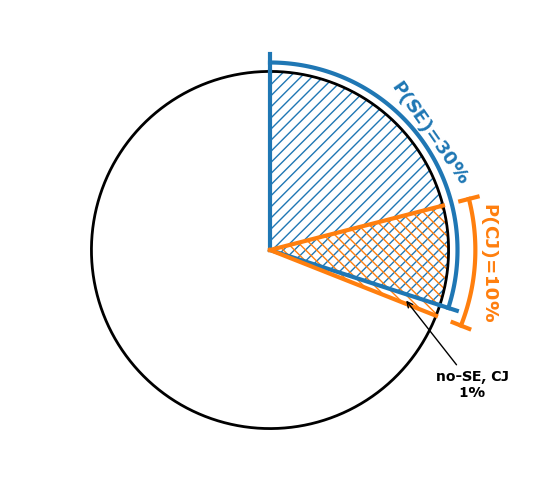
What we learn from multi-planet systems?
- Orbital eccentricities, mutual inclinations, and spacings all depend on the multiplicity, suggesting that the dynamical evolution may have reshaped the system architecture.
- Systems with more planets are dynamically colder.
- The inner (<1 AU) and the outer (~1-10 AU) planetary systems are strongly correlated, indicating that planet formation is a global behavior.
- This inner-outer correlation unexpected in theories of Kepler planet formation.
- Implications to Solar system-like architecture.
- Future prospects:
- Young multi-planet systems.
- Combining different detection techniques (e.g., transit, RV, astrometry, microlensing).
What we learn from multi-planet systems?
- Orbital eccentricities, mutual inclinations, and spacings all depend on the multiplicity, suggesting that the dynamical evolution may have reshaped the system architecture.
- Systems with more planets are dynamically colder.
-
The inner (<1 AU) and the outer (~1-10 AU) planetary systems are strongly correlated. This inner-outer correlation unexpected in theories of Kepler planet formation.
- Implications to Solar system-like architecture.
- Future prospects:
- TESS+Gaia to study the architecture of hundreds of multi-planet systems (e.g., pi Mensae, Xuan & Wyatt 2020, Damasso et al. 2020, De Rosa et al. 2020).
- Young multi-planet systems.
- Linking to cold Neptunes via microlensing surveys (e.g., Roman microlensing).

- Nearly half of Kepler planets found in systems w/ one transiting planets.
- E.g., Thompson et al. (2018), Xie et al. (2016), Berger et al. (2018, 2020).
- Transit singles & transit multis have statistical similar properties.
- E.g., Xie et al. (2016), Munoz Romero & Kempton (2018), Zhu et al. (2018), Weiss et al. (2018).
(Kepler planets around Sun-like stars, based on Kepler DR25 & Gaia parameters)
Talk outline
- Introduction, job ad, & outline (3 slides)
-
Inner multiplicity
- Mutual inclination distribution and the "Kepler dichotomy" (3 slides & refer to He talk).
- what it means, the issue, the solution (and possibly others).
- Kepler planets are dynamically compact and the eccentricity distribution (3 slides).
- period ratio distribution, dynamical spacing, interpretation.
- On the apparent correlation in planetary sizes (3 slides).
- the observation, the potential issues (two-fold).
- Mutual inclination distribution and the "Kepler dichotomy" (3 slides & refer to He talk).
-
Global multiplicity
- Hot Jupiters are lonely & friends of hot Jupiters (3 slides).
- HJ & SE, HJ & CJ, the interpretation.
- Super Earth-cold Jupiter correlation (3 slides).
- Observations (RV & transit), the theoretical implication.
- Microlensing FFPs are probably dynamically ejected planets from multi-planet systems (1-2 slides & refer to Mroz talk).
- Hot Jupiters are lonely & friends of hot Jupiters (3 slides).
-
Future prospects
- Gaia+TESS (or other transit surveys) enabling further architecture studies (1-2 slides).
- Multi-planet systems around younger stars to study how the dynamical evolution works. Briefly mention about direct imaging (1 slide).
- Roman microlensing survey as a link to the cold Neptune population (1 slide & refer to several other ulensing talks).

0.4 \(R_\oplus\)
0.9 \(R_\oplus\)
1.0 \(R_\oplus\)
0.5 \(R_\oplus\)
11 \(R_\oplus\)
9 \(R_\oplus\)
4.0 \(R_\oplus\)
3.9 \(R_\oplus\)
On the intra-system variation: Do Solar system planets show size (or mass) similarity?
- No, if knowing all planets
- Giant planets are not observable: orbital period too long
- Mercury & Mars undetectable: too small
- Yes, if only Venus & Earth are seen
See Zhu (2020) and Murchikova & Tremaine (2020).